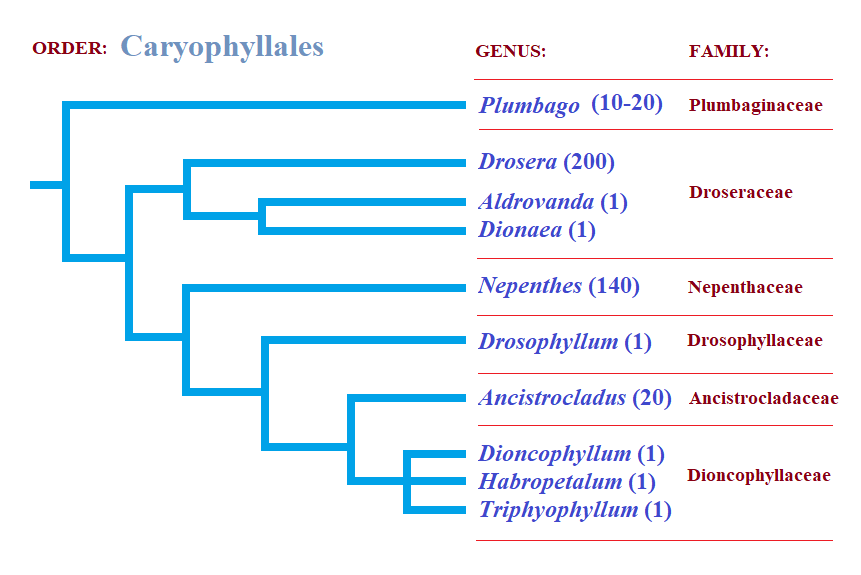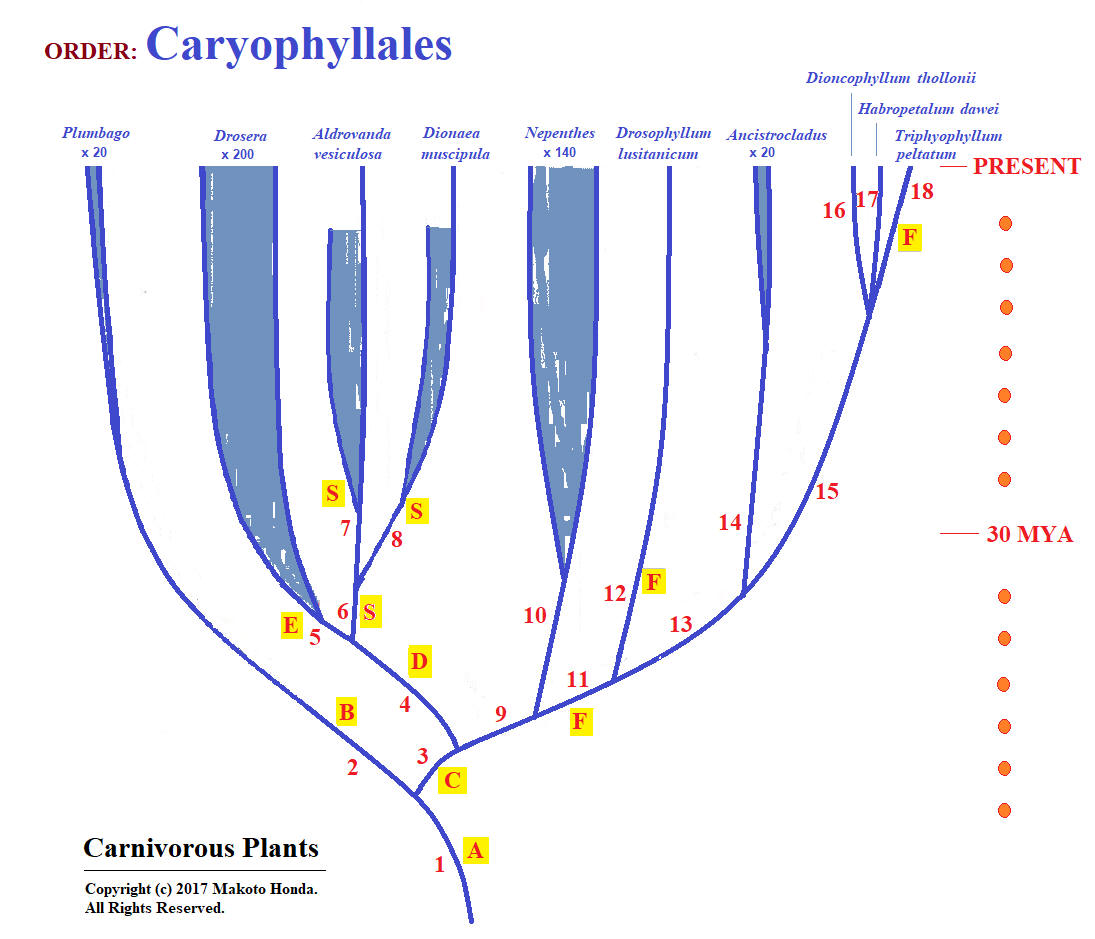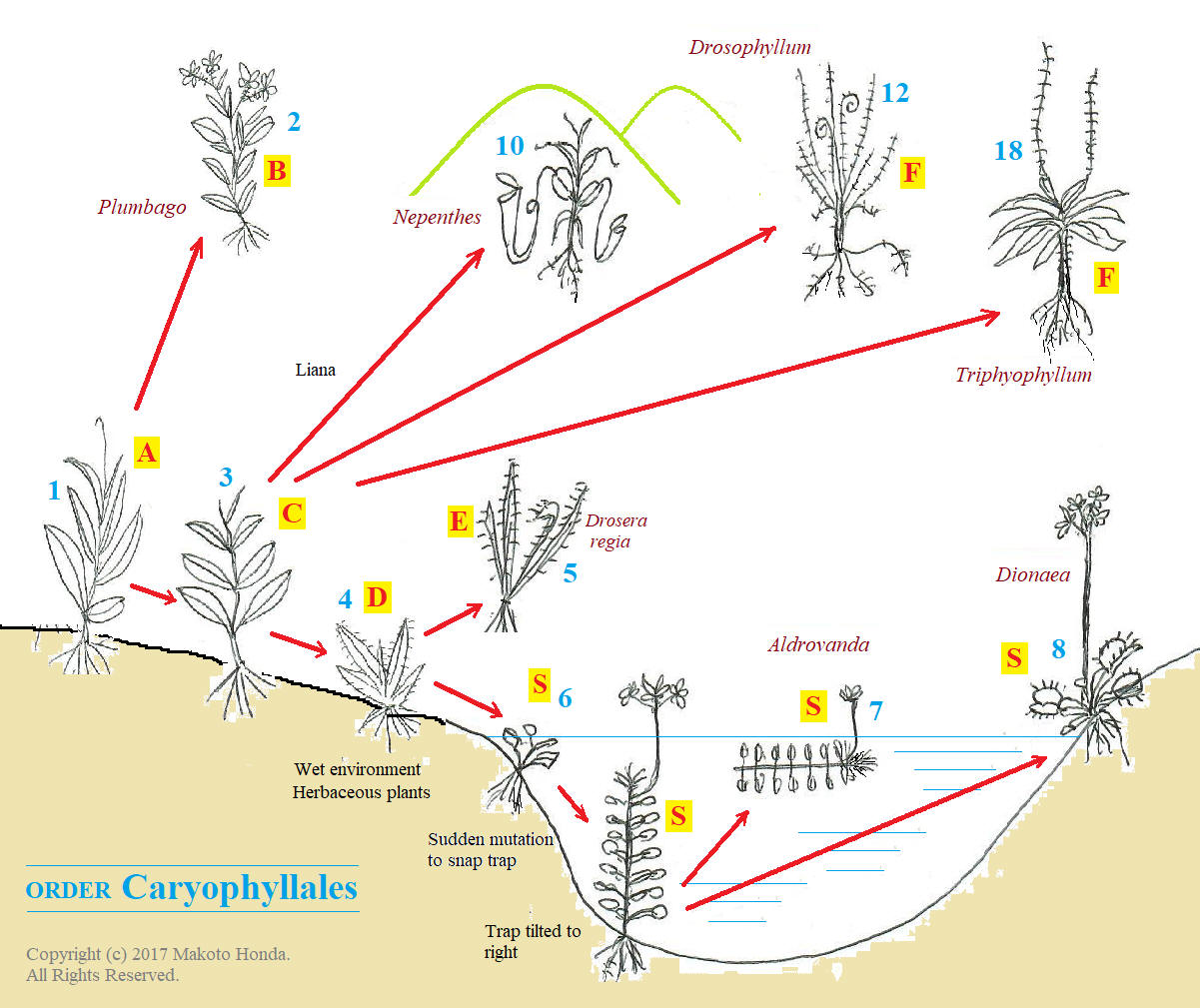Carnivorous Plants
_______
II. Caryophyllales
2017-03-15
Updated 2017-12-16
Caryophyllales

Phylogenetic Tree of the Order
Caryophyllales. Copyright (c) 2017 Makoto Honda. All Rights Reserved.

Phylogenetic Tree of the Order
Caryophyllales. Copyright (c) 2017 Makoto Honda. All Rights Reserved.
A) STICKY DEFENSE (common
ancestor)
Sessile glands
* Secretion
B) STICKY DEFENSE (Plumbago
: proto-carnivorous, calyx adhesive)
Stalked adhesive glands (simple stalk)
* Secrets adhesive mucilage for prey capture
Sessile glands
* Secretion
C) STICKY CARNIVOROUS PLANTS (primitive carnivorous plants)
Stalked adhesive glands
* Secrets adhesive mucilage for prey capture
Sessile glands
* Secretion
D) STICKY CARNIVOROUS PLANTS (ancient
sundews - herb / wet environment)
Stalked adhesive glands
* Secrets adhesive mucilage for prey capture
Sessile glands
* Absorption only - as in today's sundews
E) STICKY CARNIVOROUS PLANTS
(modern Drosera)
Stalked adhesive glands (multi-cellular
stalk, xylem)
* Secrets adhesive mucilage for prey capture
* Digestive process - enzyme secretion and
absorption
* Movement - tropistic/nastic
tentacle bending + leaf folding
Sessile glands
* Absorption only - maybe obsolete function
F) STICKY CARNIVOROUS PLANTS (Drosophyllum and Triphyophyllum)
Stalked adhesive glands (multi-cellular
stalk, xylem)
* Secrets adhesive mucilage for prey capture
* No digestive process (solely for prey capture)
* No movement
Sessile glands (division of task for
digestion)
* Digestive process - enzyme secretion and
absorption
S) snap-trap (leading to Aldrovanda
and Dionaea)
Snap-trap prey capture
* Did this happen in aquatic or terrestrial environment?
* Trap tilted to the
right...
EVOLUTION OF GLANDS - SUMMARY
Plumbago
(x 20)
Stalked glands
* Secrete salt /
mucilage
Sessile glands
* Secrete salt /
mucilage
Drosera (x 200)
Stalked glands
* Multicellular
glands / Vascularized with xylem / Epidermal or parenchymatous origin
* Movement
Sessile glands
* Non-vascularized /
Epidermal origin
Aldrovanda
(A. vesiculosa)
Sessile glands
* Non-vascularized /
Quadrifid and bifid
Marginal teeth
* Reduced stalked
glands / May be vascularzed
Dionaea
(D. muscipula)
Sessile glands
* Digestive gland
cells
Guard hairs
* Vascularized /
Homologous to the stalked glands found at the blade margin of Drosera
Nepenthes (x 140)
Nectaries
* Nectar glands /
Sunken / Covered by epidermis / Surrounded by bundles of phloem
Glandular pit
* Glands at the
pitcher base / No xylem or phloem / Partially covered by epidermis
Drosophyllum (D.
lusitanicum)--- leaf shows reverse circinate vernation
Stalked glands
* Multicellular
glands / Vascularized with xylem and phloem
Sessile glands
* Multicellular
glands / Vascularized with xylem and phloem
Triphyophyllum
(T. peltatum) --- leaf shows reverse
circinate vernation
Stalked glands
* Multicellular
glands / Vascularized with xylem and phloem
Sessile glands
* Multicellular
glands / Vascularized with xylem and phloem
Dioncophyllum (D.
thollonii)
Stalked glands
* No
Sessile glands
* No
Habropetalum (H.
dawei)
Stalked glands
* No
Sessile glands
* No
Glandular hairs
* On stems,
glandular hairs with flattened multicellular heads
Ancistrocladus (x 21)
Stalked glands
* No
Sessile glands
* No
Glandular pits
* Wax secretion / On
the abaxial side of the leaf

Carnivorous Plant Evolution Within the Order Caryophyllales. Copyright (c) 2017 Makoto Honda. All Rights Reserved.
DISCUSSION
-- Sessile Gland Development --
In the order Caryophyllales,
a precursor to carnivory started out as a primitive adhesive trap, probably to protect
their reproductive organs (flowers). That allowed prey capture but did
not provide any means of absorbing the nutrients from the captured prey.
Eventually primitive sessile glands developed that were capable of
absorption (only), as in today's sundews. The sessile glands further
developed into secreting digestive enzymes, as seen in Drosophyllum and
Triphyophyllum today.
-- Dual Function in Stalked Glands --
In Drosera, on the other hand, the stalked glands acquired the additional ability to perform digestive function (secretion of enzymes and resorption of digestion products). The tentacle's fluid secretion is switched from the initial mucilaginous glues to digestive enzymes after prey capture. Digestion is typically carried out in the center of the leaf blade where short, central tentacles grow.
Numerous sessile glands are also found on the leaf surface of sundews, and along the stalk of a tentacle in some species. It is conceivable, therefore, that the fluids containing the products of digestion drip down from the central tentacles onto the leaf surface, allowing numerous sessile glands to participate in the absorption as well.
-- Movement of Stalked Glands---
From the common ancestor (probably an adhesive trap) of all carnivores
in the order Caryophyllales,
the branch leading to modern Drosera developed a "movement" trait
in the stalked glands resulting in so called "active" traps in
their tentacle bending (and leaf folding). The branch leading to Nepenthes-lineage
(also leading to Drosophyllum and
Triphyophyllum) did not develop any such movement (or lost the
ability, but unlikely).
-- Division of Tasks --
In Drosophyllum and Triphyophyllum, the stalked
glands (without movement) are solely for adhesive prey capture and the digestion
is carried out by the sessile
glands on the leaf surface. In the order Lamiales, the same division of tasks between the
stalked and sessile glands is seen in Pinguicula's adhesive trap.
-- Evolution of Sessile glands --
In evolutionary terms, it could be interpreted that the
Drosera's primitive sessile glands (only capable of absorption) gave rise
to more advanced sessile glands found in Drosophyllum and Triphyophyllum
that are capable of secreting enzymes (Juniper et al, 1989). Perhaps, more
plausible interpretation might be that the sessile glands in sundews lost their
function
----
Drosera's sessile glands are a remnant of obsolete organs replaced by the stalked glands
(tentacles) that acquired added capability to perform digestive function (Komiya, 1994).
Within the order Caryophyllales it is difficult to assess which is more advanced
evolutionarily: the division of tasks (between stalked and sessile glands)
seen in
Drosophyllum and Triphyophyllum, or the
multi-tasking stalked glands in Drosera. However, it does appear the Drosera's
tentacles have brought precision and economy in enzyme application.
-- Efficient Enzyme Application --
In Drosophyllum and Triphyophyllum (and in Pinguicula), the digestive enzymes are secreted from the sessile glands in the vicinity of the site of prey capture in response to physical/chemical stimulations.
Sundews deliver digestive enzymes by way of well-controlled tropistic movement of the tentacles (movement towards the source of stimuli) that enables precision-dispensing of metabolically expensive enzymes to a specifically targeted area --- the prey. This minimizes waste compared with the broad enzyme secretion scheme used in other adhesive carnivores.
Copyright (c) 2017 Makoto Honda. All Rights Reserved.